SRH-940
back to Shure
back to measurements
home
Published: Nov-23-2022
NO SMOOTHING is applied to the shown plots. Most measurement sites have some smoothing applied which ‘irons flat’ sharp peaks and ‘wiggles’. I do not use smoothing because some info about sound quality is lost when plots are smoothed.
Aside from a small correction of the microphone itself also some correction in the lowest frequencies is applied to the plots to compensate for the perceived loss of bass when using headphones. This is described HERE in more detail.
A ‘horizontal‘ frequency response curve on the shown frequency response plots on this website thus indicates a perceived ‘flat’ tonal signature.
ALL measurements are made with a good SEAL on a flatbed measurement rig.
The shape of your head, bone structure, pad size, pad ‘softness, (compliance), hair or no hair and or wearing glasses may (drastically) change the frequency response of some headphones, so… your personal experience may differ substantially from these plots.
Frequency response (tonal balance) is the most sound-determining aspect of headphones. A horizontal line shows audible neutral response in the plots on this website. Deviations in different severity at different frequency bands have an effect on the sound character.
The bigger the deviation the stronger the effect.
Below an aid to help determining the sound character of headphones with relation to the frequency response.

Shure SRH-940

The Shure SRH-940 is a closed over-ear headphone. It is available in silver with black accents. It was launched in 2013 and is still being sold (end 2022). The price range is between € 200.- and € 260.-
The build quality is not that great. The one I got send in for review had the hinges (in the red ovals below) completely broken and was held together with some tie-wraps. This is a quite common complaint about this headphone.
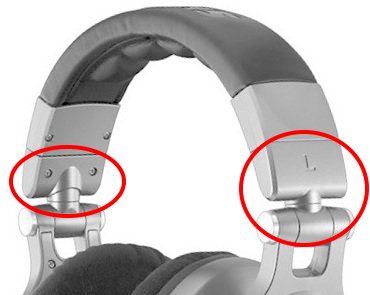
The cups can not fold entirely flat but partially and can collapse into the headphone. The headphone comes with a rather large carrying case that has a separate compartment for extra pads (that come with it), a coiled cable and a small insert with a zipper that can hold the straights cable and a threaded 6.3mm TRS adapter.
The headband can extend 40mm. The cups can tilt and swivel far enough for a comfortable fit on most heads. The headrest is pleather covered. In the used one I got for review the pvc leather-look material came loose from the cloth cushions underneath. The headband can be adjusted over a decent range. People with smaller heads may find the headrest does not rest on the head when the cups are positioned properly. The foam in the headrest cushions was still good. The plastic parts of the headband were all broken.
The cups have enough swivel (spring loaded) and tilt (180 degrees). The cups can partially fold flat so it can fit in the storage case. Trying to fold the cups completely flat will result in plastic parts breaking. The cups can fold into the headphone so it becomes a smaller ‘package’ but cannot be stored in the storage case this way.
The pads have firm regular foam inside and are covered with velour cloth that feels pleasant and are replaceable. The SRH-940 even comes with a set of spare pads. Room for the ears is not plenty though, the 60mm height and 45mm width is enough for most ears but the 18mm depth is a bit less ideal. Chances are the ears touch the pads.
The SRH-940 comes with 2 (removable) cables. One 3m coiled cable (1.5m in non-stretched condition) with a gold plated locking 2.5mm TRS jack on the headphone side and a threaded, gold plated, straight 3.5mm Jack plug. A supplied and threaded 6.3mm adapter can be screwed onto the 3.5mm and balanced outputs is terminated in a straight gold plated 3.5mm TRS plug.
The cable is microphonic. This means touching the cable and it rubbing against clothes is audible in the left cup.
The sensitivity is quite high (118dB/V @ 1kHz) so it can play impressively loud even from portable sources like phones etc. Even with EU phones with output power restrictions it can play loud.
This headphone is decent in weight (324 gr without the cable) and combined with the medium clamping force (3.5N) makes it a comfortable headphone.
specifications:
Type: Over-ear, closed
Usage: Home, Portable
Isolation: decent
Driver type: dynamic
Pads: replaceable, velour with regular foam
Inner pad dimensions: Height: 60mm, width: 45 mm, depth: 18mm, oval shaped
Collapsible: yes, folds partially flat (spring loaded)
Headphone connector: 2.5mm locking (proprietary)
Cable: 2.5m straight in gold plated 3.5mm TRS plug + 3m coiled cable
Driver size: ø 40mm
Max. power rating: 1W
Max. voltage: 5.8V
Max. current: 170mA
Max. S.P.L.: 130dB
Impedance: 33Ω (measured)
Sensitivity: 118dB @ 1V
Efficiency: 103dB @ 1mW
Weight: 324 g. (without cable)
Color: silver with black accents
Clamping force: medium-low (3.5N)
Accessories: 2x cable, spare pads, carrying case, 6.3mm adapter.
Sound description:
The sound is very realistic, dynamic and ‘open’ and hyper-detailed. That ‘hyper detail’ is also the weak point. Bass is present and sounds good but is not elevated so Harman type bass lovers should look elsewhere. Mids are full and dynamic. The treble is substantially elevated. Think ‘Beyerdynamic style’.
The treble is not grainy nor of poor quality but certainly over-the-top. This brings the illusion of a highly detailed sound and ‘transients’ at first listen but after a while, and with certain songs, the treble is ‘sharp’ sounding.
Fortunately EQ (or a filter) can remove this sharpness and the sound becomes very balanced and of good quality.
measurements:
Below the frequency response of the SRH-940 (left, right)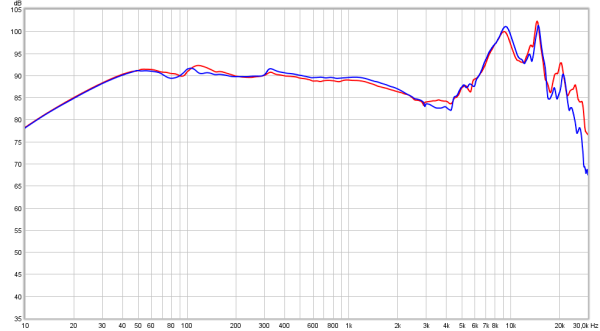
Channel matching is good. Bass response goes quite deep (30Hz -3dB) and 20Hz is only down a few dB. The frequency response is quite linear from 40Hz to1.5kHz. The small dip around 4kHz is not audible and may not be as deep in reality (pinna gain).
Above 6kHz is where the trouble starts. There is a huge peak around 9kHz and a second one around 14kHz. The 9kHz is the offending one and makes the sound sharp.
Below the phase response of the SRH-940 (left, right)
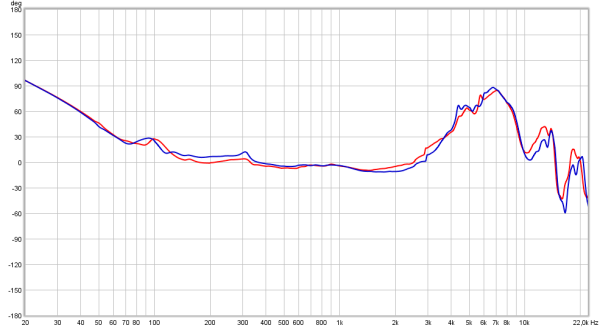 Slow phase shifts are not very audible. Steep changes in a narrow frequency bands may well be audible. Phase problems that lead to lesser sound are not seen here.
Slow phase shifts are not very audible. Steep changes in a narrow frequency bands may well be audible. Phase problems that lead to lesser sound are not seen here.
Seal
Seal is quite important for closed headphones and this headphone is no exception. Below the effect on the tonal balance is shown when the seal is not perfect. The bass suffers. Perfect seal, seal broken with thick armed glass resting against the skin, seal broken by glasses that are not flush against the skin.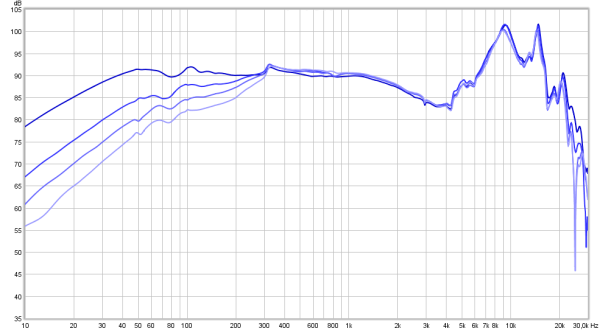
Breaking the seal lowers the amount of bass. A small leakage is already quite audible.
Comparison
Below the Shure SRH-940 versus some other Shure and other headphones.
output resistance / damping-factor
As this is a closed dynamic headphone the frequency response can be amplifier output resistance dependent when certain higher output resistance amplifiers are used.
Instead of showing impedance plots, which are hard to ‘read’ when it comes to assessing the tonal balance change in the real world, the Shure SRH-940 is measured via a few different resistance outputs (0.2Ω, 10Ω, 32Ω and 120Ω). On a higher output resistance amplifier the output level will be lower of course due to voltage division. To compensate for this the amplifier is turned up to the same level (12.6dB for 120Ω at 1kHz in this case at max. volume setting). This way the plots are overlaid and it is easier to see how the tonal balance changes.  The headphone does not react much to higher output resistances. The resonance frequency is around 80Hz. Output resistance above 32 ohm (D.F. = 1) is not recommended so less suited for usage with AVR and (older) receivers and integrated amps.
The headphone does not react much to higher output resistances. The resonance frequency is around 80Hz. Output resistance above 32 ohm (D.F. = 1) is not recommended so less suited for usage with AVR and (older) receivers and integrated amps.
Below the distortion measurements of the SRH-940 (left channel) at 90dB SPL.
Below the same distortion plot but with the vertical scale in percentages instead of level differences.
 Distortion at 90dB SPL (around 100 Hz) is a bit high (2%) and is 3rd harmonic distortion This is indicative for ‘compression’.
Distortion at 90dB SPL (around 100 Hz) is a bit high (2%) and is 3rd harmonic distortion This is indicative for ‘compression’.
The 2nd harmonic distortion above 200Hz is probably lower than shown as limits of the test rig are around 0.2%.
At 80 dB SPL (1kHz) the distortion is reaching good levels so at ‘comfortable’ listening levels the distortion is low.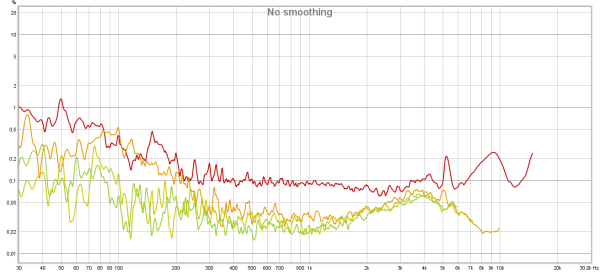
Linearity
To see how severe the compression is the SRH-940 is measured 4 times. Once at 70dB, 80dB, 90dB and 96dB SPL (at 1kHz). When the traces are overlaid and have the same shape then there is no compression visible.  Note the 2dB/div scale. There is some compression below 200Hz starting from around 80dB or so.
Note the 2dB/div scale. There is some compression below 200Hz starting from around 80dB or so.
This means there is little distortion at comfortable levels but when playing louder the distortion increases quickly. This is audible as the bass sounding a bit muddy and not well defined.
Below the CSD of the SRH-940 (Left and Right are overlaid).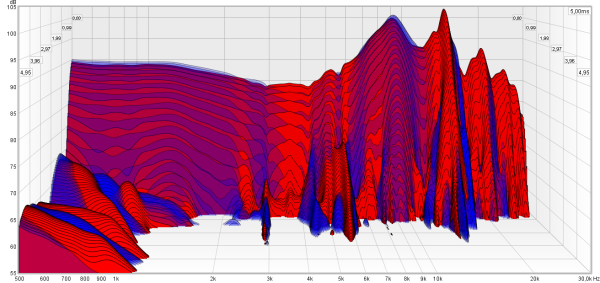 Above 4kHz some resonances are showing up. Strangely enough the elephant in the room (9kHz) has a very short decay.
Above 4kHz some resonances are showing up. Strangely enough the elephant in the room (9kHz) has a very short decay.
Below the spectrum plot of the SRH-940 (left channel).  There is a very short lived low level lingering around 3kHz but that is of no importance.
There is a very short lived low level lingering around 3kHz but that is of no importance.
Below the group delay plot of the SRH-940 (left)
Around 70Hz there is some ‘pad bounce’ but this is very small. At just over 300Hz there is a small resonance visible.
The step response of the SRH-940 (left, right)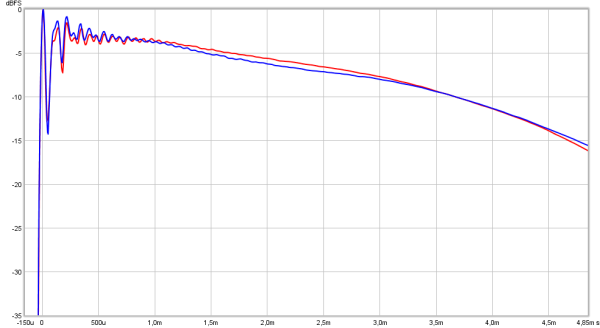
There is a lot of ringing and overshoot in the first 250μs which shows the sharp sound signature.
The slow and gradual downward slope after 250μs shows the neutral sound character and good bass extension.
Pad change
To increase the comfort (thicker pads, 22mm instead of 18mm) the Shure SRH-1540 Alcantara pads (HPAEC1540) can easily be fitted instead of the stock velour pads. This results in a few dB more bass and a bit less sharpness. Still some EQ is certainly needed in the upper treble.
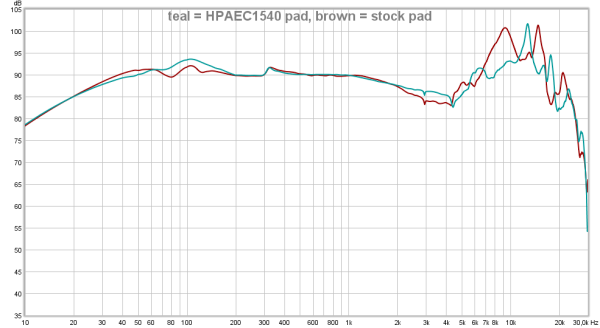
A simple but effective way of reducing the treble peak is by putting a 3-layer piece of toilet paper between the pad and the driver as shown below. (notice this is an SRH1540 pad)
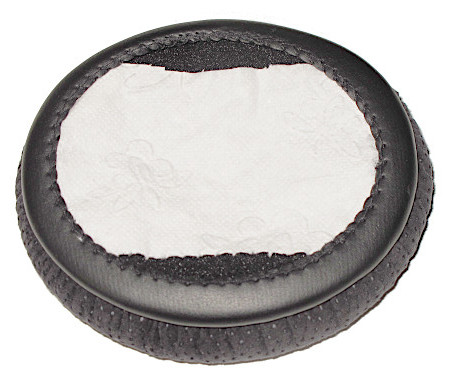
Below the effect of 3 plies of toilet paper on the original SRH940 pads vs stock pads.
 As can be seen the treble peak is drastically reduced.
As can be seen the treble peak is drastically reduced.
Treble peak filter
The treble peak can also be addressed with parametric EQ or passively with a filter.
Below the schematic for a filter that removes the treble peak.

With the treble peak sorted it was kind of a shame to simply throw away otherwise fine drivers.
Fortunately I still had the (modified) Pioneer SE-MS5T-K lying around doing nothing and decided to mount the SRH-940 cups onto its sturdy and simple headband. A little bending of the metal parts, drilling holes and sealing some now existing leakages the headphone ended up looking like this.
As the grey plastic parts were all damaged and ugly I also painted those black.
Mounted SRH-1540 pads on it for comfort (thicker pads and pleasant to wear) and added the toilet paper mod. Because of the needed sealing of holes the frequency response altered a bit.
Below the headphone shown above but with the original SRH-940 velour pads.
 And below the CSD belonging to this headphone.
And below the CSD belonging to this headphone.

With the SRH-1540 pads the response became a bit warmer but better treble and a bit less bass-extension. This is shown below.

summary
The Shure SRH-940 could have been a very good headphone worthy of a $ 200-300 price tag.
The tonal balance from bass to upper mids is very good and the sound is dynamic, comfort is good as well. The treble is where it isn’t sounding good anymore. The treble is peaking and needs to be lowered. This can be done with parametric EQ or a passive filter (when digital EQ is not an option)
Once the treble is lowered this headphone sounds quite good.
Unfortunately the build quality (actually the plastic hinges and headband) is of such poor quality that I cannot see this headphone to last very long with professional usage. At least that’s the intended market. Also the non replaceable pleather headband padding is not something to write home about.
Maybe when one is handling this headphone very carefully it might last a bit longer.
Unfortunately there are too many horror stories about the headband to ignore this.
